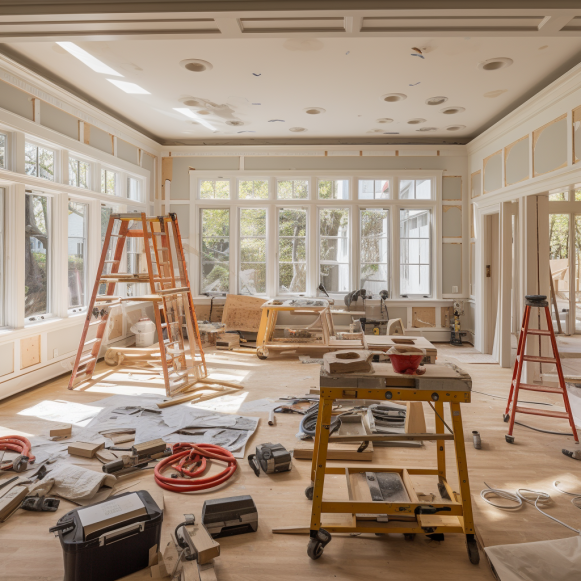What’s the difference between a home renovation and a remodel?

Before embarking on a new project, it’s critical to understand the distinctions between a remodel and a renovation.
Not only does each have its own set of costs, time frames, and permit requirements, but they may also differ in terms of the value you’ll recoup from your investment. Considerations such as these can aid in guiding your decision and determining the scope of the project you select.
Renovation versus remodeling
Though the terms are frequently used interchangeably, remodels and renovations differ depending on the scope of the project.
When considering a home renovation, consider it a refresh or minor makeover. A renovation typically includes projects that homeowners choose to do themselves, such as painting, replacing kitchen cabinet hardware, and updating lighting. These projects are “spruce-ups” for your home’s aesthetics. Home renovations are inexpensive and can often be started and completed in the same weekend.
Consider a remodel to be a reconstruction or large-scale project. A home remodel usually entails hiring professionals and obtaining permits before the project begins.
Raising a ceiling, moving a bathtub to a new wall, adding an extension or new room, or even installing a kitchen island complete with plumbing and electricity are all examples of remodels. A remodel is a significant investment that can be quite costly depending on the size and scope of the changes.
The cost of remodeling versus renovation
A simple renovation can often be completed for under a thousand dollars. After all, paint supplies and light fixtures are relatively inexpensive. A home remodel, on the other hand, could set you back thousands of dollars.
According to HomeAdvisor, remodeling and renovation costs average around $49,000, with most home projects ranging from $18,000 to $81,000.
According to the data, home remodels can cost anywhere between $5,000 and $150,000 or more. Home renovations typically cost $10 to $60 per square foot, but can cost up to $150 per square foot depending on the room, your location, the size of your house, and the materials used.
Which is better for you: renovate or remodel?
When deciding which home improvements to prioritize, think about which projects will provide the best return on investment. Some changes will increase the value and equity of your home more than others.
According to Remodeling’s 2023 Cost vs. Value Report, you’ll recoup 102.7 percent of what you spend on a garage door replacement but only 22.7 percent of what you spend on an upscale master suite addition. This study compares the average cost of 22 home remodeling projects as well as the estimated value of each project.
Other factors must be considered in addition to the value impact. For example, it’s usually best to only spend money renovating or remodeling rooms that you use frequently, and you should think about how long you intend to live in your home. If you are planning a move in the near future, a simple renovation may be the best option for you. The smallest details can change the energy of a room without breaking the bank.
A home remodel may be the better option if it is your forever home and the changes will increase the home’s functionality. For example, if you frequently host large dinner parties but have a small dining room and kitchen, it makes sense to do a large-scale remodel of that area to make it more functional for your needs — even if the project won’t yield a high return on investment in terms of property value.
Before deciding on the scope of the project, how much money you want to spend, and where you want to spend it, consider your budget, motivations, value payoff, and future intentions with the home.
How to Finance a Renovation or Remodel
Many homeowners choose a personal loan, a home equity loan, or a home equity line of credit (HELOC) to finance remodels and renovations.
Individual loan
A personal loan can often be obtained in an amount greater than the credit card limit, and it will most likely have a lower interest rate than a credit card. As a result, personal loans are a less expensive way to finance any major home improvement project.
Personal loan interest rates fluctuate, but they currently range from 5% to 36%, depending on the lender and factors such as your income, debt-to-income ratio, and credit score. Personal loan terms can range from one to ten years, with loan amounts ranging from $1,000 to $100,000.
Home equity line of credit
If you have equity in your home, a home equity loan may outperform a personal loan and be easier to obtain. A home equity loan uses a portion of the equity in your home to secure a lump-sum loan that can be repaid over time.
This type of loan is ideal for large remodels because it allows you to borrow a large sum of money at a low interest rate. The disadvantage is that if you are unable to repay the loan, your home will be used as collateral.
Home equity credit line
A HELOC, like a home equity loan, allows you to borrow against your home equity, but it’s structured more like a credit card. If you meet the requirements, you will be given access to a line of credit equal to a portion of your home equity, which you can use as needed.
Many people who are doing home remodels or expensive renovations prefer HELOCs to home equity loans because the former provides them with more financial flexibility. It’s an excellent solution for projects that don’t have a set budget or that may end up being on a larger scale than anticipated.
The draw period is typically 10 years, and you are only required to pay interest on any amount borrowed during that time. You can also repay the principal during the draw period in order to replenish your line of credit before borrowing again. Following the end of the draw period, you will make regular monthly payments on both the interest and the principal.
In conclusion
When it comes to time, cost, and financing, there are significant differences between renovation and remodeling. Consider which projects will provide the best return on your investment while also improving the functionality of your home while you live in it.






